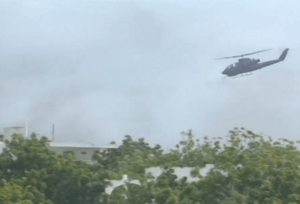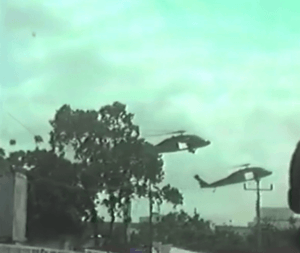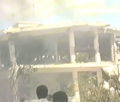Abdi House raid facts for kids
Quick facts for kids Bloody Monday/Abdi House Raid |
|
|---|---|
| Part of United Nations Operation in Somalia II | |
| Location | Hodan District, Mogadishu, Somalia |
| Date | July 12, 1993 10:18am (UTC+03:00) |
|
Attack type
|
Air strike |
| Weapons | TOW missiles and 20 mm caliber cannon fire |
| Deaths | UNOSOM II claim - 7 to 20 (All combatants) Red Cross claim - 54 |
|
Non-fatal injuries
|
UNOSOM II claim - None Red Cross claim - 161 Somali claim - 200 |
| Victims | Habar Gidir and other subclans |
| Assailants | United States Army |
|
Number of participants
|
Six AH-1 Cobras, Four OH-58 Kiowas, Five UH-60 Black Hawks |
| Motive | Hostilities between General Mohamed Farrah Aidid and United Nations Operation in Somalia II |
The Abdi House raid or Operation Michigan is an event that Somalis call Bloody Monday (Isniinta Dhiigii). It was a surprise attack by American forces in Mogadishu, Somalia, on July 12, 1993. This attack was part of the United Nations efforts during the Somali Civil War.
This event changed the UN mission (UNOSOM II) greatly. It made many Somalis angry at the UN and Americans. This anger led to strong resistance against the US military during the Battle of Mogadishu a few months later.
The attack happened after General Mohammed Farah Aidid was blamed for an attack on Pakistani peacekeepers on June 5, 1993. The US government allowed American forces to attack a house. This house belonged to Aidid's Interior Minister, Abdi "Qeybdiid" Awale.
A big meeting was happening at the house. Important elders from Aidid's clan, the Habr Gidr, were there. They were trying to find a peaceful way to end the conflict between Aidid's group, the SNA, and the UN forces.
Contents
Why Did the UN Attack the Abdi House?
Planning the Surprise Attack
After the attack on Pakistani peacekeepers, the UN decided to arrest those responsible. They passed Resolution 837. General Aidid was not named directly, but his group, the SNA, was blamed.
This started a cycle of increasing violence. The UN launched air strikes and tried to capture Aidid. In return, Aidid's group attacked UN forces and killed UN employees. The UN's attempts to capture Aidid kept failing.
US military leaders then suggested attacking "The Abdi House." They wanted to weaken Aidid's group. Abdi "Qeybdiid" Awale's house was known for holding clan meetings. Since Qeybdiid was a high-ranking member of Aidid's group, his house became a target.
The UN had tried to show that they were not against the Habr Gidr clan. They said they only wanted to capture Aidid. Planning for the attack on Qeybdiid's villa began on July 7, 1993.
Decisions Before the Raid
UN commanders wanted a surprise attack. They decided not to give any warning. This was different from earlier UN operations. They believed a warning would put American troops at risk.
The US military did not have the right tools for a quick capture mission. They saw the attack as a way to weaken Aidid's support. They also worried that Italian forces might be making a secret peace deal with Aidid.
Not giving a warning meant that American lives were prioritized over Somali civilian lives. The head of UNOSOM II, Admiral Johnathan Howe, could have stopped this. But he allowed the change in tactics.
The White House approved the operation. It is unclear if President Clinton knew that Somalis would be directly targeted. This attack was unique because it targeted people, not just buildings.
The Meeting at Abdi Qeybdiid's Villa
On July 12, 1993, a large meeting was held at the villa. Important elders, thinkers, business people, and clan members were there. They belonged to the Habr Gidr and other Somali clans.
They gathered to discuss a peace offer from Admiral Johnathan Howe. Howe had asked them to find a peaceful way to end the war between Aidid's group and UNOSOM II. The clan decided to focus on clan unity.
They planned to create a Supreme Council and hold an election. This meeting was important to explain these decisions. Aidid did not approve of the meeting.
Abdi Qeybdiid's villa was chosen because it had a large meeting room. Mogadishu newspapers had even announced it as a peace conference. A reporter present confirmed that elders were meeting to end the violence.
A CIA informant told the US that the meeting was happening. The informant also said that some people involved in the June 5th attack might be there. Aidid was reportedly warned about the attack hours before it happened.
How the Attack Happened
The Air Strike
On the morning of July 12, 1993, the attack began. American forces, including the 10th Mountain Division, launched Operation Michigan. They had been watching the compound for days.
The US State Department had received a warning about a planned attack by Aidid's group. This gave American commanders a reason to launch their assault. Later, it was found that the CIA report was wrong.
Seventeen helicopters took off from Mogadishu International Airport. They quickly surrounded the villa. Around 10:18 AM, a CIA informant walked out of the house. He wore special clothes as a signal.
Seconds later, without warning, six AH-1 Cobras and four OH-58 Kiowas attacked. They fired sixteen TOW missiles and 2,200 rounds of cannon fire for about six to eight minutes.
The missiles hit the second floor, where the meeting was. They also targeted the roof to prevent anyone from escaping. A pilot said their orders were to destroy the conference room and the staircase.
About 80 to 100 Somalis were gathered on the second floor. They included respected elders, poets, and professors. The first missile exploded, tearing a hole in the wall. The oldest elder, Sheik Haji Mohamed Iman Aden, was killed instantly.
Some people jumped from the second floor to escape. One missile and some cannon rounds missed the villa. They hit near the French Embassy. Civilians not part of the conference were also killed. Aidid was not at the meeting.
The Ground Assault
At 10:23 AM, after the air attack stopped, three Black Hawk helicopters landed. They carried 53 soldiers. One Black Hawk landed on the roof of the French Embassy. This gave them a good view of the villa.
The other two Black Hawks landed on the street. Troops quickly surrounded the house. Soldiers then entered the house to search for survivors and information.
The UN said it took nine minutes for troops to clear the area and leave. This made the Abdi House raid the fastest UNOSOM II operation. The entire raid lasted about 17 minutes. Two survivors were taken prisoner.
Who Was Hurt?
The International Committee of the Red Cross reported 54 Somalis killed and 161 wounded. This count came from two hospitals in Mogadishu. The actual number might be higher.
Somalis claimed 73 people were killed and 200 wounded. UN officials denied these numbers. A war correspondent present said the raid was much deadlier than US and UN officials admitted.
Many important figures died, including Sheik Haji Mohamed Iman Aden and poet Moallim Soyan. Doctors Without Borders said one of their Somali administrators was also killed.
UNOSOM commanders first said only 7 Somalis were killed. They later changed this to 13, then 20. They claimed all were armed men.
An advisor to UNOSOM II noted that American troops could not have counted the dead properly. The stairs to the second floor were destroyed. UNOSOM II never proved that the Abdi House was a military target with no civilians.
Bloody Monday was the deadliest single attack in Mogadishu since the civil war began. Many of those killed had supported peace talks with the UN.
A former US National Security Adviser said the raid was not meant to kill people.
What Happened After the Attack?
World Reactions
Many aid and human rights groups criticized the attack. UNOSOM II command in Mogadishu received copies of the Geneva Conventions. These rules cover attacks on civilians.
Doctors Without Borders said it was "a killing under the flag of humanitarianism." Human Rights Watch called it "mass murder."
The attack received a lot of attention in Italy:
- Italian newspapers called it a "vile American raid" and "unjustifiable."
- The Vatican newspaper said the mission's goal had been forgotten.
- Somalis protested in Rome.
- Italian politicians called it a "useless and irresponsible act of war." They said Italian troops should leave if the mission was not only about aid.
In the United States, Senator Robert Byrd called for US troops to leave Somalia. Another politician, Sherrod Brown, also urged withdrawal.
In the United Kingdom, there were protests at the American embassy.
In Germany, politicians tried to stop German soldiers from going to Somalia.
In Kenya, a newspaper headline asked, "Who Are the Warlords Now?" Kenyan media also called for a review of the UN's armed policy.
Pakistan and France supported the raid. Pakistan's Foreign Ministry said it prevented chaos.
Many Western news organizations left Somalia after four journalists were killed. This meant less news coverage during the Battle of Mogadishu later that year.
UN and UNOSOM II Responses
UN officials disagreed about the meeting's purpose and the number of deaths. They claimed the conference was a meeting of Aidid's war council. They said the operation was a success.
UN officials claimed:
- No warning was given because the Abdi House was a military building.
- "No innocent civilians were injured." They said "All were adult males. All were armed."
- Johnathan Howe said there was "no evidence of non-combatant casualties." He called the house a "key terrorist planning cell."
- An army spokeswoman said photos showed it was a "forward command center."
- A report claimed top financiers and military planners were killed. Later, it was admitted that elders were killed, but they were called combatants.
The UN said the raid was based on information that militia leaders would be there. Some US helicopter pilots even claimed Aidid was the informant.
UNOSOM II Disagreements
The attack caused major disagreements among countries helping UNOSOM II. Italy, Kuwait, Saudi Arabia, and Zimbabwe threatened to leave. Italy felt the mission had become an American fight against Aidid.
Italy had ruled Somalia for 50 years. They believed the attack would make the civil war worse. The Italian defense minister said his country did not support such risky actions.
A Pakistani officer noted that the American-Italian clash was harming UNOSOM II. After the raid, Italy, France, and other countries stopped joining anti-Aidid operations. Much of the aid work also stopped.
The attack also upset UN civilian staff. At least nine UN aid workers resigned in protest. They felt the UN had lost its moral standing.
Ann Wright, a top UN official in Somalia, wrote that the UN's credibility was hurt. She said they could not accurately state who was killed or why. These disagreements led to a quiet period in UNOSOM operations until August 1993.
Somali Reactions
The attack made Somalis very angry. Mogadishu became very tense. Aid work almost stopped because foreigners, especially Americans, were in great danger.
Many Somalis saw Americans as acting on their own within UNOSOM. Local cooperation with the UN disappeared. On July 12, Aidid's group announced they would fight until the "last colonial soldier" left.
In the following days, parts of the city became chaotic. UNOSOM positions were attacked repeatedly. A former UN envoy said the attack was "incomprehensible and unjust." He noted that Somalis now saw the UN as an "occupation force."
Before Bloody Monday, many Somalis believed the UN was being manipulated by Egypt. But the attack changed their minds. An SNA spokesman said, "We only want peace and reconciliation, and all we get is bombs."
Abdiqasim Salad Hassan, a future President of Somalia, had pushed for peace talks. But after the raid, he gave up. Even Aidid's opponents could not publicly support the raid.
Aidid gained more support from groups that had been against him. Many Somalis felt the peacekeepers had gone too far. Leaflets calling for revenge against American soldiers spread. Armed groups looked for Americans. Attacks on UNOSOM II forces doubled in July and August 1993.
The raid changed Somali attitudes as much as the attack on Pakistanis had changed UN attitudes. Many Somalis still feel deep anger about the attack.
What Led to the Battle of Mogadishu?
The Abdi House raid was the first time UNOSOM II forces intentionally targeted people. This was a major turning point. For the Habr Gidr clan and others, the attack was a declaration of war from the US. It made a peaceful solution seem impossible.
US special envoy Robert B. Oakley said the incident made many non-Habr Gidr Somalis sympathize with Aidid. It also increased Aidid's support within his own clan. Oakley noted that before July 12, the US was only attacked for being with the UN. After July 12, the US was specifically targeted.
Many Somalis and aid groups believed the strike was an unnecessary escalation. They felt the Americans and UN peacekeepers had become just another fighting group. UN officials even warned of more similar raids.
To thousands of city residents, Aidid's warnings about foreign control seemed true. This helped him gain power across different clans in Mogadishu. The city became much more dangerous for international troops.
The attack was meant to destroy Aidid's power. Instead, it made him stronger and increased opposition to UNOSOM. Aidid's group successfully portrayed the fight as patriots against foreign invaders.
See Also
Images for kids




